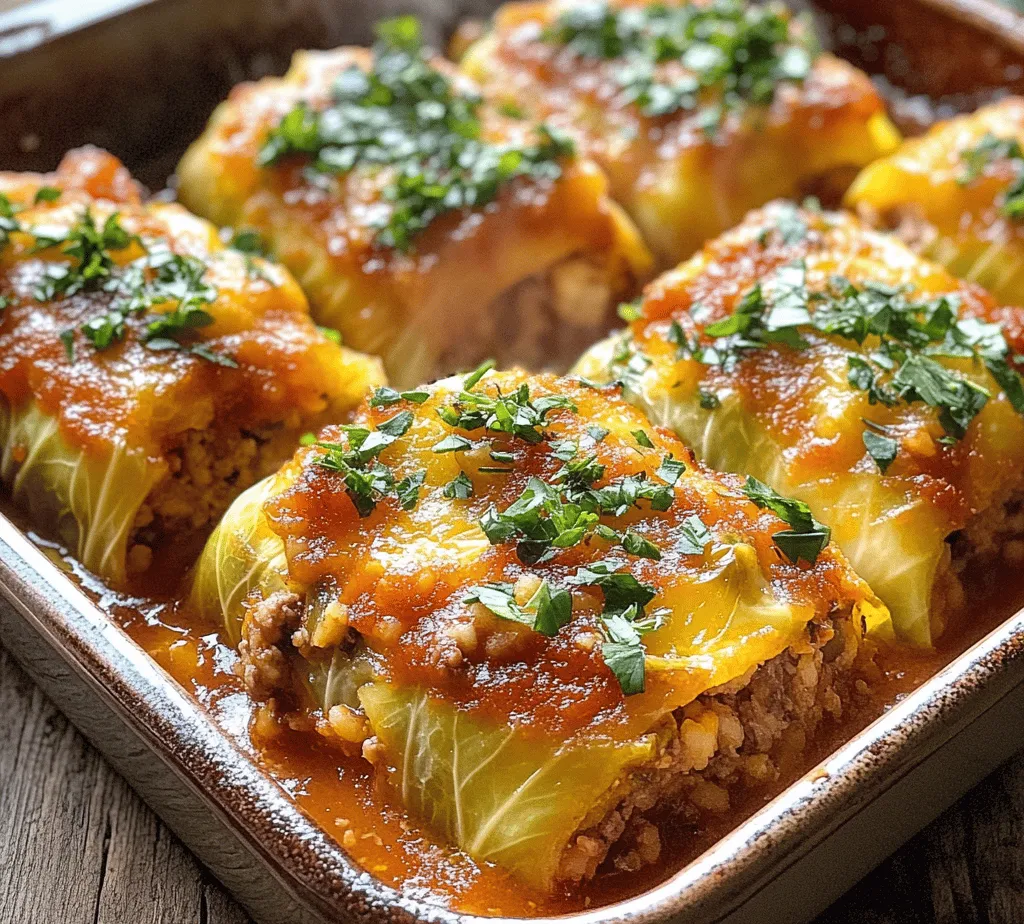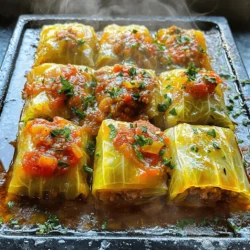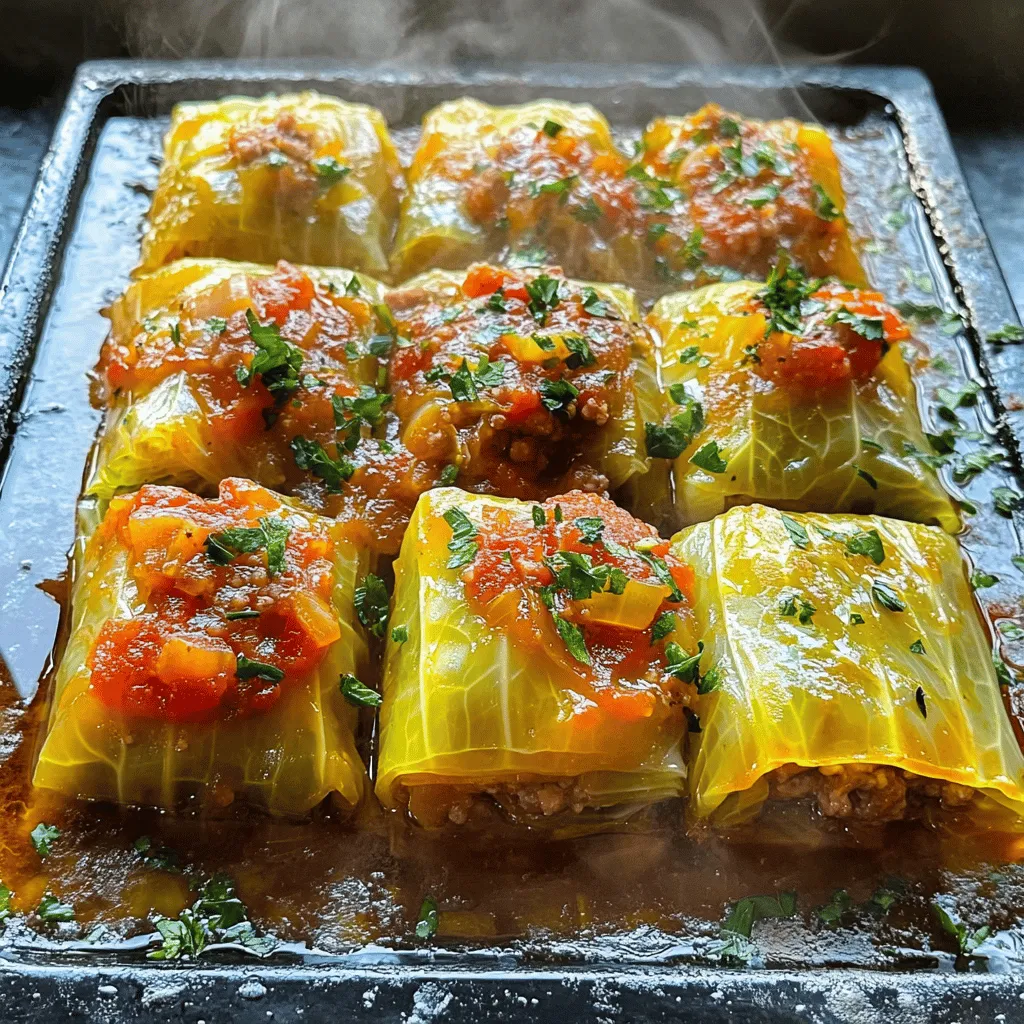Introduction
Cabbage Rolls Delight is not just a dish; it’s a hearty embrace of comfort and nutrition that brings warmth to the dining table. Perfectly encapsulating the essence of home-cooked meals, this recipe features tender cabbage leaves lovingly wrapped around a savory filling, usually comprised of ground meat and rice, then bathed in a rich tomato sauce. It’s the kind of dish that evokes nostalgia, family gatherings, and the joy of sharing meals with loved ones.
Cabbage rolls, known by various names around the world, have a rich history that spans cultures and continents. In Eastern Europe, they are often referred to as “golabki” in Poland or “sarmale” in Romania, while in the Middle East, similar dishes are known as “stuffed cabbage.” Each culture has its unique twist, yet they all share the same core ingredients and the comforting act of wrapping flavors in cabbage leaves. This dish has stood the test of time, remaining a beloved staple due to its versatility and the ability to feed a crowd.
In our fast-paced world, the importance of homemade meals cannot be overstated. Preparing traditional dishes like Cabbage Rolls Delight allows us to connect with our roots, embrace culinary traditions, and savor the satisfaction of crafting something delicious from scratch. The process of making cabbage rolls can be an enjoyable activity for families, encouraging collaboration in the kitchen while filling the home with delightful aromas.
Understanding the Ingredients
To create an unforgettable Cabbage Rolls Delight, it’s essential to understand the key ingredients that contribute to its flavor and texture. The primary components include cabbage, ground meat, rice, and tomatoes, each playing a vital role in the overall experience of the dish.
Cabbage
Cabbage is the star of the show, providing a sturdy yet tender vessel for the filling. This leafy vegetable is not only delicious but also packed with nutrients. Cabbage is an excellent source of vitamins C and K, fiber, and antioxidants, making it a valuable addition to a balanced diet. Its low-calorie content makes it a suitable choice for those looking to maintain a healthy lifestyle. Moreover, the process of blanching cabbage leaves before rolling them helps soften their fibrous texture, making them pliable enough to wrap around the filling without tearing.
Ground Meat
The choice of ground meat is pivotal in determining the flavor and health profile of your cabbage rolls. Ground beef is a traditional option that brings rich flavor and juiciness to the dish. However, for those seeking a leaner alternative, ground turkey is an excellent choice. Turkey offers a lighter taste and lower fat content, making it a popular choice for health-conscious eaters. The decision between beef and turkey can depend on personal preferences and dietary considerations, but both options will yield delicious results in your cabbage rolls.
Rice
Rice serves as a binding agent in the filling, adding texture and bulk to the dish. Whether you choose white, brown, or a wild rice blend, rice complements the meat and herbs, creating a well-rounded flavor profile. Brown rice, in particular, is a healthier option due to its higher fiber content and nutty flavor, which can enhance the overall taste of your cabbage rolls.
Tomatoes
The sauce that envelops the cabbage rolls is equally important. Tomatoes, whether in the form of canned diced tomatoes, tomato sauce, or crushed tomatoes, provide acidity and sweetness, balancing the richness of the meat and rice filling. This sauce not only enhances the flavor but also keeps the cabbage rolls moist during cooking, ensuring they emerge tender and full of flavor.
Herbs and Spices
A successful Cabbage Rolls Delight is incomplete without the addition of herbs and spices. Paprika, thyme, and parsley are essential for elevating the dish’s flavor profile. Paprika adds a subtle smokiness, while thyme contributes earthiness, and fresh parsley offers a burst of brightness. The right blend of these ingredients can transform your cabbage rolls from ordinary to extraordinary, making each bite a delightful experience.
Preparation and Cooking Process
Creating Cabbage Rolls Delight is a labor of love that involves several steps, each contributing to the dish’s overall success. Here’s a detailed guide to preparing your cabbage rolls:
Prepping the Cabbage
The first step in making cabbage rolls is preparing the cabbage. Choosing the right cabbage is crucial; look for a large, firm head of green cabbage with tightly packed leaves. Savoy cabbage is also a fantastic option due to its tender leaves, which are easier to work with.
Once you have selected your cabbage, the next step is blanching. Blanching is an essential technique that softens the cabbage leaves, making them pliable and easier to roll. To blanch, follow these steps:
1. Bring a large pot of water to a boil.
2. Carefully remove the core of the cabbage and place the entire head in the boiling water.
3. Boil the cabbage for about 2-5 minutes, or until the outer leaves become tender and easily peel away.
4. Using tongs, remove the cabbage from the water and place it in an ice bath (a bowl filled with cold water and ice) to stop the cooking process.
5. Once cooled, gently peel away the individual leaves, taking care not to tear them. Set the leaves aside to drain.
This blanching process is vital for ensuring that your cabbage leaves are soft enough to wrap around the filling without breaking, allowing your rolls to maintain their shape during cooking.
Making the Filling
With the cabbage prepped, it’s time to focus on the filling. The filling typically consists of sautéed onions, garlic, ground meat, rice, and a mix of herbs and spices. Here’s how to prepare the filling:
1. In a large skillet, heat a tablespoon of olive oil over medium heat.
2. Add finely chopped onions and minced garlic to the skillet. Sauté for about 3-5 minutes until the onions are translucent and fragrant. This step is crucial as it builds flavor right from the start.
3. In a mixing bowl, combine your cooked rice (it’s best to use rice that has cooled down), ground meat of choice, sautéed onions and garlic, chopped parsley, paprika, thyme, salt, and pepper. Mix well until all ingredients are thoroughly incorporated.
The sautéing of onions and garlic not only adds depth of flavor to the filling but also infuses the meat with a savory aroma that will shine through in the final dish.
Filling the Cabbage Leaves
Once your filling is ready, it’s time to assemble the cabbage rolls. Here’s how to effectively roll your cabbage leaves:
1. Take a blanched cabbage leaf and place it on a clean, flat surface.
2. Spoon about 2-3 tablespoons of the filling onto the leaf, near the stem end.
3. Fold the sides of the leaf over the filling, then roll from the stem end towards the top, tucking in the sides as you go to seal the filling inside.
4. Repeat this process with the remaining leaves and filling until all cabbage rolls are assembled.
Rolling cabbage leaves can take some practice, but the key is to be gentle yet firm. A well-rolled cabbage roll will hold its shape during cooking, ensuring that the delicious filling doesn’t escape.
—
In the next part of this article, we will cover the cooking process, the best methods for achieving flavorful cabbage rolls, and some tips for storing and reheating leftovers. Stay tuned as we continue to explore the delightful world of Cabbage Rolls Delight!

Suggestions for Variations in Filling
Cabbage rolls are a versatile dish that can easily accommodate a variety of fillings, catering to different dietary preferences and flavor profiles. While the traditional mixture often includes ground meat, rice, and spices, there are numerous ways to switch things up. For a vegetarian option, consider substituting the meat with a combination of cooked quinoa or brown rice, black beans, and finely chopped vegetables such as mushrooms, carrots, and bell peppers. This not only adds flavor but also enhances the nutritional profile of the dish.
For those looking to incorporate different grains, farro or bulgur wheat can serve as excellent substitutes for white rice, providing a nuttier flavor and chewier texture. You might also experiment with adding lentils to the mix; they are not only protein-rich but also add a lovely earthiness to the rolls. For a Mediterranean twist, consider adding feta cheese, olives, or sun-dried tomatoes to your filling. The key is to balance flavors and textures while ensuring that the filling remains moist and flavorful.
Creating the Sauce
The sauce is a crucial component of cabbage rolls, adding depth and flavor to the dish. Typically made with crushed tomatoes or tomato sauce, the base can be enhanced with a variety of ingredients. Onions and garlic sautéed in olive oil can provide a savory foundation, while a splash of vegetable or chicken broth adds moisture. The right balance of flavors is essential; you want your sauce to be a harmonious blend of sweet, savory, and acidic notes.
To achieve this balance, consider adding a pinch of sugar or a drizzle of honey to counteract the acidity of the tomatoes. Incorporating balsamic vinegar or lemon juice can introduce a bright acidity that cuts through the richness of the rolls. For those who enjoy heat, a dash of red pepper flakes or chopped jalapeños can elevate the flavor profile. Customizing your sauce with herbs such as basil, oregano, or thyme can also enhance the overall taste, lending a fresh, aromatic quality to the dish.
Assembling and Baking the Cabbage Rolls
Once your filling and sauce are prepared, it’s time to assemble the cabbage rolls. Begin by spreading a thin layer of sauce at the bottom of your baking dish. This not only prevents the rolls from sticking but also infuses them with flavor as they bake. Place a generous spoonful of filling in the center of each cabbage leaf, fold in the sides, and roll tightly from the stem end to the tip. Ensure that your rolls are snug but not overly tight, allowing them to expand during cooking.
Arranging the rolls in the baking dish is crucial for even cooking. Place them seam-side down in a single layer, and if you have any remaining filling, sprinkle it over the top. After arranging the rolls, cover them with additional sauce, ensuring they are generously coated. This layering technique helps to keep the rolls moist throughout the baking process.
Bake the cabbage rolls in a preheated oven at 350°F (175°C) for approximately 45 minutes to an hour. The baking time may vary based on the size of your rolls and the type of filling used. To ensure they are cooked through, check that the internal temperature has reached at least 165°F (74°C). Allow them to cool for a few minutes before serving, as this will help the flavors meld together beautifully.
Serving Suggestions
When it comes to serving cabbage rolls, presentation makes all the difference. Garnish your dish with fresh herbs, such as parsley or dill, to add a pop of color and flavor. A dollop of sour cream or a sprinkle of grated cheese can elevate the dish even further, providing a creamy contrast to the savory rolls.
To round out your meal, consider pairing cabbage rolls with a light, refreshing salad. A simple green salad with a lemon vinaigrette complements the richness of the rolls nicely. Crusty bread or garlic bread can also serve as an excellent accompaniment, perfect for soaking up any extra sauce.
Should you have leftovers, they store well in an airtight container in the refrigerator for up to four days. Reheating is simple; just place them in the oven at 350°F (175°C) for about 20 minutes or until heated through. Alternatively, you can warm them in the microwave for a quicker option. The flavors actually deepen after a day or two, making them a delightful meal for the days ahead.
Nutritional Information
Cabbage rolls are not just a comfort food; they are also a nourishing meal option packed with nutrients. Each serving typically contains around 250-300 calories, depending on the filling and sauce used. They provide a good balance of protein, carbohydrates, and fiber, making them a fulfilling dish. On average, you can expect approximately 15-20 grams of protein, 10 grams of fat, and 30-40 grams of carbohydrates per serving.
Cabbage itself is low in calories but high in vitamins C and K, making these rolls a great choice for anyone looking to boost their nutrient intake. Additionally, incorporating whole grains and legumes into your filling can enhance the fiber content, promoting digestive health.
For those with dietary restrictions, cabbage rolls can be easily adapted. A gluten-free version can be achieved by using gluten-free grains and ensuring that your sauce is free from gluten-containing ingredients. For a low-carb option, consider using cauliflower rice instead of traditional grains, which can reduce the overall carbohydrate content significantly.
Conclusion
Making Cabbage Rolls Delight is not just about creating a meal; it’s about sharing a cherished recipe that can bring family and friends together. The joy of cooking these rolls lies not only in the delicious flavors but also in the memories created around the dinner table. Whether you are enjoying them for a special occasion or a cozy weeknight dinner, these cabbage rolls are sure to become a family favorite.
Feel free to experiment with the recipe, trying different fillings and sauces to find your perfect combination. Homemade meals foster connections and traditions that can be passed down through generations, making each bite a taste of love and care. So gather your loved ones, roll up your sleeves, and dive into the delightful world of cabbage rolls!


